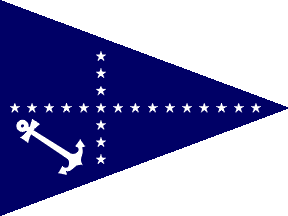 image
by Željko Heimer
image
by Željko Heimer
Last modified: 2017-11-11 by ian macdonald
Keywords: navy | cruzeiro | stars: 21 (white) | anchor | captain | commander | lieutenant commander | senior officer |
Links: FOTW homepage |
search |
disclaimer and copyright |
write us |
mirrors
Source: Album des Pavillons, 2000
.Triangular blue pennant with 21 white stars as in the Cruzeiro and
with white slanted anchor in lower hoist quarter. The stars are
arranged 3 above, 3 below, 5 to hoist and 9 to fly of the central
star. This agrees with MB Ceremonial.
Željko Heimer, 25 March 2001
Source: Album des Pavillons, 2000
.The same flag in shape of trapezoid. The fly size
seems to be about 1/3 of the hoist.
The flag is used by the other two higher officer ranks under the
captain, those being commander and Lieutenant Commander (or, in the
"French" system of ranks [as used by Brazil--ed.] these would be Captain of Frigate and
Captain of Corvette).
Željko Heimer, 25 March 2001
Source: Album des Pavillons, 2000
.The triangular Cruzeiro, as for a captain commanding a force, without the
anchor and with a star in the upper fly quarter. This agrees with MB Ceremonial, from
which we learn that this is only
used for senior officers if they hold rank of higher officers (captain,
commander, or lieutenant commander). There are special designs for the senior commander
present afloat if the COMAPEM is an admiral.
Željko Heimer, 25 March 2001
Source: Album des Pavillons, 2000
.Long triangular white pennant with single blue star. Ratio seems to be about 1:7~.
I guess that this flag replaces the masthead pennant when either the senior commander present
afloat pennant or a senior admiral's flag are hoisted elsewhere on the ship. The
MB Cerimonial mentions the flag, too.
Željko Heimer, 25 March 2001
The terminology for these flags is quite different. The flag referred to in MB Cerimonial as the flag or pennant of
COMAPEM, which stands for Comandante mais antigo presente embarcado,
or senior commander present afloat, is hoisted "only in the ship in which the most senior (antigo) officer is found."
By contrast, this white pennant is described as "hoisted in small boats (embarcacões miúdas)
that are carrying a higher officer (oficial supérior, not mais antigo) in uniform, being lowered as
soon as the officer disembarks. That sounds to me like a pennant flown in the bow to indicate the presence of a
captain, commander, or lieutenant commander--grades which are designated as "higher officers"
as opposed to either admirals (oficiais gerais) or intermediate officers and subalterns (lieutenants). It seems
clear from MB Ceremonial that the white pennant with one blue star is not a substitute for the warship or
commissioning pennant.
Joseph McMillan,12 June 2001
Source: Album des Pavillons, 2000
.The triangular Cruzeiro without any other charge.
In agreement with MB Ceremonial.
Željko Heimer, 25 March 2001